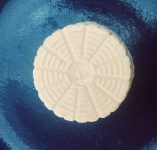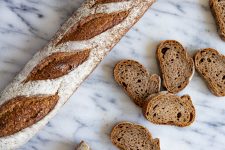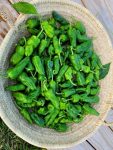Fantastic Ricotta Cheese at Zingerman’s Creamery
 Bellwether Farms Jersey Cow’s Milk Ricotta
Bellwether Farms Jersey Cow’s Milk Ricotta
The food world here has come an enormously long way in the thirty-two years we’ve been in business. Ingredients that for years we could only get by going to Europe—padron peppers, fresh sardines, great naturally-leavened breads, Iberico Bellota ham, etc.—are now routinely part of our work and our eating here at Zingerman’s. In fact, I’m so spoiled that when I go to Europe now I often lament the lack of high quality ingredients. Sure, in the right places you can get great food, but the average offerings even in France and Italy these days more often than not aren’t all that amazing.
That said, there are still a few things that are way better on the other side of the Atlantic. For most of my life, ricotta was one of those things. While there are some very reasonable offerings on the American market made by good people whose work I very much appreciate, I would respectfully say that we haven’t had access to ricotta with the kind of flavor and texture I love so much in Italy.
Here’s what I wrote on the subject many years ago:
Actually I can almost tell you to the day when it was that I had this ricotta revelation. It was the first week of November 1992, right before Bill Clinton defeated George Bush I for president. I was down in Rome to visit the people who make our Pecorino Romano. As we toured the Pecorino production, out of the corner of my eye I noticed a couple of workers stirring a large, steel, steam-shrouded kettle off to one side of the room. A few minutes later they start to slowly scoop out small mounds of soft white cheese from the kettles. These in turn are set softly into a series of small baskets—some white plastic, some natural wicker—sitting alongside each vat.
“What are they doing over there?” I asked my host. “Oh that? That’s ricotta,” he said as if it were the most obvious thing in the world.
We walked over to where the baskets were draining and offered me a taste. It was warm, lighter in the hand than it looked to be. I tasted it and had one of those “aha” eating experiences that stay with me forever. This stuff was incredible. Light, puffy, fluffy, sweet, so delicious that I could have just kept eating it and eating it all day.
For most of the last two decades, one of the best parts of going to Italy was that I got to eat a lot of that sort of really good ricotta. A few years ago, my ricotta fix became easier to fill when Liam Callahan at Bellwether Farms in Petaluma started to make what I could call Italian-quality fresh ricotta.
Long time Bay Area food writer and well-known cheese aficionado Janet Fletcher wrote about Bellwether’s work a while back. “Several years ago, on vacation in Sicily,” she said, “I took a daylong cooking class withAnna Tasca Lanza, the aristocratic proprietor of Regaleali, a venerable wine estate. I still recall one of the pasta dishes she made by tossing wild mustard greens with penne and the fresh sheep’s-milk ricotta made on the premises. When I got home and tried to duplicate it, I didn’t like the results because our domestic ricotta was so different. Sicilian ricotta, thinned with some of the pasta water, produced a creamy sauce with a crème fraîche taste. American ricotta was too sweet and grainy. Recently I made that recipe again, using a new cow’s-milk ricotta from Sonoma County’s Bellwether Farms. The dish tasted almost as if the Marchesa Tasca Lanza herself had made it.”
All of which meant that for the last few years, on my frequent trips to the Bay Area, I would buy up as much of the Bellwether ricotta as I could. A few weeks ago I walked into Zingerman’s Creamery and much to my surprise, just to the left of the beer and wine shelves, was a container of Bellwether ricotta. Turns out we can now get it weekly through a distributor in Chicago. What a totally happy surprise! I’ve bought five containers of it in the last three weeks.
“In Italy,” long time cheesemaker Lino Esposito once explained to me, “we have three types of ricotta. We have the southern ricotta, which is made of sheep’s milk. Then there is the ricotta of the islands—on Sardinia they make a blend of sheep’s milk and goat’s milk. And then there is the ricotta of the north, which is made from cow’s milk.” What Janet Fletcher would have had on Sicily is likely the first on Lino’s list. Bellwether’s is the third variety—cow’s milk ricotta made in the style of the north.
Long time specialty food guru Darrell Corti from Sacramento told me years ago that “eating great fresh ricotta is like eating clouds” and I’ll stand by his statement. I could eat the Bellwether ricotta by the spoonful. Actually I do. But it’s also excellent with pretty much everything! On toast, on pasta, in pasta (super great for stuffing ravioli or anything of that sort). Topped with a great honey (the Deli has some amazing ones—try the new blackberry honey that just arrived from the Pacific Northwest) it’s a fabulous dessert! Be great drizzled with that amazing dark cane syrup we’re getting from Charles Poirier in Louisiana. Now that I think about it some of this ricotta, a little Lutenitsa and a few slices of the sesame semolina bread would be a beautiful light lunch.
In 1986 Cindy Callahan was looking for a way to keep the grasses on their pasture trimmed and decided to try using sheep. Great natural grass cutting! The sheep that started as organic lawn mowers were also of course milk providers and soon thereafter she and her son Liam started to make cheese. Four years later Bellwether Farms was the first licensed sheep dairy in the state of California.
“Making ricotta was a natural extension of making aged sheep cheeses,” Liam laid out. “All the creameries we saw in Italy made ricotta with their whey and it made sense for us to do so as well. Once we started making our cow’s milk cheeses I developed our recipe for our Jersey whey ricotta. We take great care in making our ricotta and within the last 18 months added a whole milk Jersey milk ricotta to our lineup.” The latter is the one we have in stock right now.
“Our ricotta gets its flavor and necessary acidity from being cultured rather than adding acid (vinegar, citric acid, etc.).” Liam told me. I think this lets us have the best texture (really difficult to achieve because the Jersey milk is so high in protein) and by far the most flavor of any ricotta out there.” I agree fully.
On ricotta-making days the Callahan crew drives up the road to get the fresh milk. “Our Jersey milk producer milks around 200 cows but we only buy about half of it. They have been there farming for just over 100 years now,” Liam said, “and they still have three generations actively working the farm.” The milk is gently pasteurized and then made into cheese that same day. As with our Creamery’s great goat cheese (I had a one day-old fresh City Goat yesterday that was truly exceptional) it’s done completely by hand. They stir the curd by hand to start the process. When the cultured milk starts to float in the kettle it’s skimmed off and gently placed into the special plastic baskets in which it’s shipped. The handwork isn’t just romantic. It protects the texture and flavor of the delicate curd and it makes a really big difference in the cheese.
Ig Vella (the man known for his incredible California Dry Jack cheese) told me years ago about the days when the family dairy in Sonoma included regular ricotta making in its repertoire. “My uncle was an excellent ricotta maker,” he told me once with obvious pride and a touch of sadness. “In those days you had to keep the Fridays”—the day of the week on which Catholics weren’t allowed to eat meat—”so that was the biggest day’s production. It was fabulous cheese. But the state ruined it when they told us we had to pack the ricotta as soon as it was made. It was never the same from that point on. It just couldn’t drain right.” When his uncle died in 1963, the Vellas stopped making ricotta. The Callahans have fixed this problem by ladling the fresh cheese into perforated plastic baskets that allow the whey to drain while still protecting the cheese inside a shippable, state-approved, plastic-sealed-for-safety package.
This should be a good season for us as ricotta eaters. As Liam explains, “The seasons of the year affect the milk from both the cows and the sheep. In the spring the solids drop but the grassy aromas increase as they are in the fresh grass. The milk from the Jersey cows gets even more yellow color. When the animals are on the fresh grass the curd tends to be a bit softer.”
Elizabeth Minchilli recently wrote about a really nice dish of Tuscan black kale, stemmed, lightly cooked in olive oil with a bit of fresh chopped garlic and salt (when the kale is hot, add a bit of water to wilt it while it’s cooking). When the kale is tender, chop it (the food processor is fine if you pulse, not puree) and add, then chopped fairly fine and mixed with fresh ricotta and grated Pecorino Toscano. Toss it with hot, short pasta. The Baia pac-macs are great as are Martelli maccheroni or Primograno penne lisce.
Another great pasta dish on my ricotta-fixated mind is also from Elizabeth (I told you she’s good!)—pasta with ricotta, zucchini and mint. Start with sliced zucchini cooked slowly for a long time in a lot of good olive oil until they caramelize. Cook pasta really al dente. Take out a bit of the cooking water and mix with a good bit of the Bellwether ricotta. When the pasta is very al dente pull it out of the cooking pot and add to the zucchini. Cook for a minute or two stirring regularly. Add the ricotta-sauce to the pan, stir once or twice to warm it and then pour the whole thing into warm serving bowls. Top with freshly grated Parmigiano Reggiano and plenty of ground black pepper.
I’ll leave the last words on this to Liam. “Ricotta is a deceptively simple cheese,” he makes clear. “It really is unfortunate that the industrial versions can still use the name, but isn’t that so often the case? This cheese holds a place close to my heart because of the many months of trial and error my mom and I spent at our 30-gallon test kettle making batches hoping to unlock the secret to making this with no added acid. I am sure you have experienced the gratification of seeing something start to work and then become something amazing. Each time I see the expression on a person’s face the first time they try it I am reminded how fortunate I am to be able to do what I do.”
![]()




Zingerman’s Art for Sale